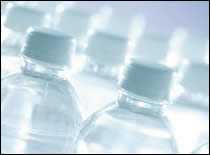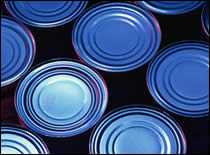Food and Water Concerns
Emergency Water Storage And Purification
Following are recommendations for storing and purifying water supplies:
-
 The minimum drinking water supply is 1 gallon per person per day. You will also need water for food preparation, bathing, brushing teeth, and dish washing. Store a 3-5 day supply of water (at least 5 gallons for each person).
The minimum drinking water supply is 1 gallon per person per day. You will also need water for food preparation, bathing, brushing teeth, and dish washing. Store a 3-5 day supply of water (at least 5 gallons for each person). - Water should be stored in sturdy plastic bottles with tight-fitting lids. Rinsed chlorine bleach bottles work well for water storage. Plastic containers for juice and milk do not work as well because they tend to crack and leak more readily. All containers should be labeled.
- Stored water should be changed every 6 months.
- Avoid placing water containers in areas where toxic substances, such as gasoline and pesticides, are present. Vapors may penetrate the plastic over time.
- Do not store water containers in direct sunlight. Select a place with a fairly constant, cool temperature.
Safe Water Sources In The Home
If you do not have enough water stored, there are sources in your home that may provide safe, clean water for drinking purposes.
- Water drained from the water heater faucet, if the water heater has not been damaged.
- Water dipped from the tank of the toilet (not the bowl). The water in the bowl can be used for pets. Do not use water that has been chemically treated or "blue" water.
- Melted ice cubes.
- Canned fruit, vegetable juice, and liquids from other canned goods.
- Water from swimming pools and spas can be used for personal hygiene, cleaning, and related uses, but not for drinking.
Unsafe Water Sources
Never use water from the sources listed below for drinking.
- Radiators
- Hot water boilers (home heating system)
- Water beds (fungicides added to the water or chemicals in the vinyl may make water unsafe for use)
NOTE: Remember that carbonated beverages do not meet drinking water requirements. Caffeinated drinks and alcohol dehydrate the body, which increases the need for drinking water.
Water for Drinking and Cooking
Safe drinking water includes bottled, boiled, or treated water. Your state, local, or tribal health department can make specific recommendations for boiling or treating drinking water in your area. Here are some general rules concerning water for drinking and cooking. Remember:
- Do not use contaminated water to wash dishes, brush your teeth, wash and prepare food, or make ice.
- If you use bottled water, make sure the seal has not been broken. Otherwise, water should be boiled or treated before use. Drink only bottled, boiled, or treated water until your supply is tested and found safe.
- Boiling water kills harmful bacteria and parasites. Bringing water to a rolling boil for 1 minute will kill most organisms.
- If you can't boil water, you can treat water with chlorine tablets, iodine tablets, or unscented household chlorine bleach (5.25% sodium hypochlorite). If you use chlorine tablets or iodine tablets, follow the directions that come with the tablets. If you use household chlorine bleach, add 1/8 teaspoon (~0.75 milliliter [mL]) of bleach per gallon of water if the water is clear. For cloudy water, add 1/4 teaspoon (~1.50 mL) of bleach per gallon. Mix the solution thoroughly and let it stand for about 30 minutes before using it. Treating water with chlorine tablets, iodine tablets, or liquid bleach will not kill many parasitic organisms. Boiling is the best way to kill these organisms.
Containers for water should be rinsed with a bleach solution before using and reusing. Use water storage tanks and other types of containers with caution. For example, fire truck storage tanks, as well as previously used cans or bottles, can be contaminated with microbes or chemicals.
Emergency Food
Keep foods that:
- have a long storage life
- require little or no cooking, water, or refrigeration, in case utilities are disrupted
- meet the needs of babies or other family members who are on special diets
- meet pets' needs
- are not very salty or spicy, as these foods increase the need for drinking water, which may be in short supply
How To Store Emergency Food
- A disaster can easily disrupt the food supply at any time, so plan to have at least a 3-day supply of food on hand.
-
 When storing food, it is not necessary to buy dehydrated or other types of emergency food. Canned foods and dry mixes will remain fresh for about 2 years.
When storing food, it is not necessary to buy dehydrated or other types of emergency food. Canned foods and dry mixes will remain fresh for about 2 years. - Certain storage conditions can enhance the shelf life of canned or dried foods. The ideal location is a cool, dry, dark place. The best temperature is 40 to 60°F. Keep foods away from ranges or refrigerator exhausts. Heat causes many foods to spoil more quickly.
- Keep food away from petroleum products, such as gasoline, oil, paints, and solvents. Some food products absorb their smell.
- Protect food from rodents and insects. Items stored in boxes or in paper cartons will keep longer if they are heavily wrapped or stored in airtight containers.
- Date all food items. Use and replace food before it loses freshness.
How To Use Emergency Food
- Use perishable food in your refrigerator or freezer before using food in your emergency supplies.
- Discard cooked, unrefrigerated foods after 2 hours at room temperature, regardless of appearance.
- Eat only foods that have a normal color, texture, and odor.
- Discard cans that bulge at the ends or that are leaking.
Preparing Food
Preparing food after an earthquake may be complicated by damage to your home and loss of electricity, gas, and water. The following items will help you to prepare meals safely:
- Cooking utensils
- Knives, forks, and spoons
- Paper plates, cups, and towels
- A manual can- and bottle-opener
- Heavy-duty aluminum foil
- Gas or charcoal grill; camp stove
- Fuel for cooking, such as charcoal. ( CAUTION: Never burn charcoal indoors. The fumes are deadly when concentrated indoors.)
NOTE : Do not use your fireplace for cooking until the chimney has been inspected for cracks and damage. Sparks may escape into your attic through an undetected crack and start a fire.
- Page last reviewed: January 4, 2008
- Page last updated: September 21, 2017
- Content source:


 ShareCompartir
ShareCompartir


